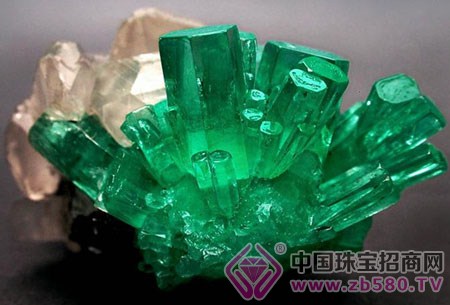The main producing areas of emerald are Colombia, Russia, Brazil, India, South Africa, Zimbabwe and so on. The most common emeralds on the international market come from three origins: Colombia, Brazil and Zambia.

Colombia
The emerald produced in Colombia is famous for its good color, good texture and high yield. It is the world's largest high quality emerald producing area. The two most important emerald deposits in Colombia are Muzo and Chivor, which are located about 100km northeast of Bogotá, in the Cordillera Mountains. Colombian emeralds began production in the mid-16th century, when the emerald mine was owned by the occupiers of the Spanish, and it was not state-owned until 1886. For centuries, the Muzuo and Chival mines have been the world's largest supply of quality emeralds, monopolizing the international market, accounting for about 80% of the world's total quality emerald production.
Colombian emeralds are mainly produced in the calcite and feldspar veins of the sedimentary rock series. The surrounding rocks are carbonaceous shale and limestone. The calcite veins containing emeralds, the dolomite veins of dolomite, and the pyrite veins of pyrite are generally 60m long. It is 0.1 to 20 cm wide and has veins and veins. Emerald is plaque-like in the veins. The emerald is a columnar crystal with an average length of 2 - 3 cm and a light green to dark green color. Slightly blue, good texture and transparent. Carbon monoxide bubbles, liquid sodium chloride and cubic salt, etc., are found in the emerald crystals. This is very rare in emeralds in other regions, only Colombian emeralds. In addition, there are often inclusions such as pyrite, black carbonaceous materials, crystals, and chromite. Appraiser Xiao Changyao believes that the blue color of emerald green emerald in the Chival mining area is the best, and it is the most beautiful emerald in the world. In 1969, a huge emerald weighing 7025 carats was found in Colombia.
The emeralds produced in Colombia have long been known, and one of the lesser-known Dalbe grainy emeralds is unique in the world.
In 1946, this rare emerald gemstone, Dalbez, was first discovered in the famous mining area of ​​Muzo, Pena Blanca. The original meaning of Spanish was: grinding sucrose. Because the center of the gemstone has a six-sided core, which radiates six lines of the sun's rays, forming a star-shaped pattern, hence the name. The locals are convinced that this is a special gift from God. Every line represents blessings: health, wealth, love, luck, wisdom, happiness. Because of the special nature of the gemstones, they are polished to a curved surface without planar cutting. With the closure of the Biblanka mine, the existing Dalbez is even more precious. The star of Andes, now in the British Empire, London Victoria and Abbott Museum: weighs 80.61 carats.
Colombian emerald is recognized as the best in the world, its color is pure green, a few are yellow-green or blue-green; cracks are more, carbon monoxide bubbles, liquid sodium chloride and cubic salt are visible in the crystal, liquid, solid Three-phase inclusions - this feature is unique to Colombian emeralds, as well as fibrous inclusions, pyrite inclusions, yellow-brown granular fluorocarbon calcium strontium inclusions, quartz inclusions, pyrrhotite inclusions And molybdenum ore inclusions.
Russia
The Russian Ural emerald was discovered by a farmer in 1831 and the mining area is located near Sverdlovsk. Thousands of carats of high-quality emeralds have been produced for over a century. The deposit is produced in the phlogopite quartzite of the ultrabasic rock, which is a metamorphic ultrabasic rock, in which many granitic pegmatites and fine-grained rocks invade. Emeralds are uneven plaques in the mica rock. The emerald is light green and dark green with a slight yellow hue. Most of them are columnar crystals, sometimes flat plate crystals, with an average length of 3 to 5 cm. Emerald crystals often contain cations, irregular arrays, and biotite inclusions, which are leaf-like and scaly. The minerals of emeralds are apatite, phlogopite and the like.
South Africa
The South African (Azania) emerald deposit was discovered in 1927. The deposit is located in the biotite schist and biotite-chlorite schist near the pegmatite contact zone. The formation of emeralds is the same as the volatile gas. The formation of hydrothermal fluids is closely related to the interaction of ultrabasic rocks. The emerald crystal is a flattened plate containing biotite and sulfide inclusions. The emerald color has a banding phenomenon, from light green to dark green, and the crystal is generally 3 to 5 cm long. The emeralds located in the northeastern deposit of Transvaal in South Africa are of very high quality, but the crystals are small, and the associated minerals are tourmaline, gold emerald, topaz and so on. South Africa is still one of the world's leading producers of emeralds. In 1956, it discovered a 24,000-carat high-quality emerald crystal, the world's largest emerald crystal.
Zimbabwe
The Zimbabwe Emerald Deposit was discovered in 1957. The output is very large and has become a major exporter of emerging emeralds in the world. The deposit is produced in Archean crystalline rock, and the surrounding rock is a translucent schist and a chlorite schist. Emeralds are unevenly distributed phenocrytic output. The ore body is 300--500 m long, 0.2--10 m thick and 100-200 m deep. Emerald is less than 10% in the ore belt. The high-quality emerald accounts for 5% of the total newly produced emeralds. The emerald is a hexagonal columnar body with an average crystal grain size of 1--3mm and a large crystal size of 3cm. The emerald has a small particle size but high quality and bright green. Very beautiful, associated minerals such as gold emeralds.

Brazil
Brazilian emeralds have a lot of origins, but the emerald crystals are small and sturdy. In 1962, high-quality emeralds were discovered in Bahia. This deposit is in the pegmatite of the ancient metamorphic rocks and its adjacent mica quartzite. The crystals are almost completely transparent, but most of the colors are lighter.
Zambia
Zambia's emerald quality is a surprise: the emeralds produced in the area have good transparency and rich emerald green, often with a slight blue tint, which is very beautiful. The quality of quality people can be comparable to that of Colombia.
Tanzania
In 1970, a high quality emerald deposit was discovered in the National Park on the west bank of Lake Manyara, Tanzania. Emerald is produced in the veins of massive pegmatite and biotite schist. The formation of emeralds is related to the interaction of granitic pegmatites into metamorphic ultrabasic rocks. The emerald-containing mica rocks are often associated with pegmatite veins, and the minerals associated with emeralds are gold emeralds, garnets, reds, sapphires, apatites, and the like. The emerald color is yellowish green, light green and light green, and the crystal is small, generally 0.1 to 5 cm, and the largest is 4 cm.
Pakistan
The Peshawar emerald deposit in Pakistan was discovered in 1958, and the deposit extends northeastward with an area of ​​180 mu. The surrounding rock is a talc schist with snake veins invading, and a large number of reticulated hydrothermal quartz veins are mineralized. The emerald enrichment in the lower talc schist is cystic. Emerald formation is related to the contact metamorphism between the granitic pegmatite and the chromium-bearing metamorphic rocks. The emerald crystals in the quartz vein are broken, and the emerald crystals in the talc schist are intact, dark green, transparent, and most crystals are larger than 1 carat, but most contain inclusions. Premium emeralds can be compared to Colombian emeralds.
India
The emerald deposit in Rajasthan, India, was discovered in 1943. The emerald-bearing ore belt is large in size, 200km long from north to south and 30km wide. Emerald formation is associated with the intrusion of granitic pegmatite into metamorphic ultrabasic rocks. The emerald is unevenly distributed with porphyry, and the surrounding rock is strongly mixed lithified biotite schist and gneiss. The emerald crystal is small, has many cracks, and the quality is poor. The crystal is columnar and flat, with an average length of 3-5 cm, the color is light green to dark green, and transparent-translucent.

Australia
The Australian Persian emerald deposit began mining in 1909 and is the only emerald mine in Australia. The deposit is produced in the mica schist of metamorphic ultrabasic rock invaded by granitic pegmatite, which is a high-temperature gas-rich heat rich in volatile matter. An emerald deposit formed by the action of liquid and ultrabasic rocks. The emerald crystal is hexagonal column, 2cm long, light green - yellow green. Emerald crystals contain less inclusions and higher overall quality. Gem-quality emeralds account for 11% of the total emeralds produced.
Afghanistan
There is also Afghanistan in the emerald-producing area. The emerald grows in the hydrothermally altered marble and mica schist, and the Huichang-long diorite rock wall. It is produced in quartz with a thickness of 2.3m and a length of 10m. In the carbonate veins. The emerald is dark green, less transparent, and generally 1-1.5 cm long. In 1973, the largest crystal was 2.8 cm.
Austria
Salzburg, Austria is the only emerald producing area in Europe, and some emeralds have been produced in the Middle Ages. The emeralds here are small in size and rarely exceed 1-2 carats. Moreover, it is a low-quality emerald.
Emerald origins include North Carolina, Norway, etc. in the United States. Some emerald-like crystals have also been found in Yunnan, China, and they can be considered emeralds regardless of their color, composition and chromium oxide content. The crystal length is 5-8cm, it is light green, multi-envelope, a lot of transverse cracks, more opaque or translucent, is a low-grade emerald, can only honed plain gemstones. Emerald is produced in the old metamorphic schist, which is said to be large in scale and extremely distant. Emeralds are distributed in many countries.
- 100% MULBERRY SILK - Our silk bed sheets was made of 100% mulberry silk, Highest Grade 6A, yed With No Color Shading Or Fading; Offering Your Skin Second Protection.
- High Quality Craftsmanship & Design - Professional produced seamless silk flat sheets.
- Perfect for Hot and Cold Sleepers - Silk bed sheets natural temperature regulating properties keep you comfortable in every season. It can effectively reduce hot or cold irregularities when sleeping by wicking moisture from the body and adjusting to body temperature
Silk Bedding,Silk Bedding Set,Silk Bedsheets,Silk Comforter Set
Nantong Otter Textile , https://www.ottertextile.com